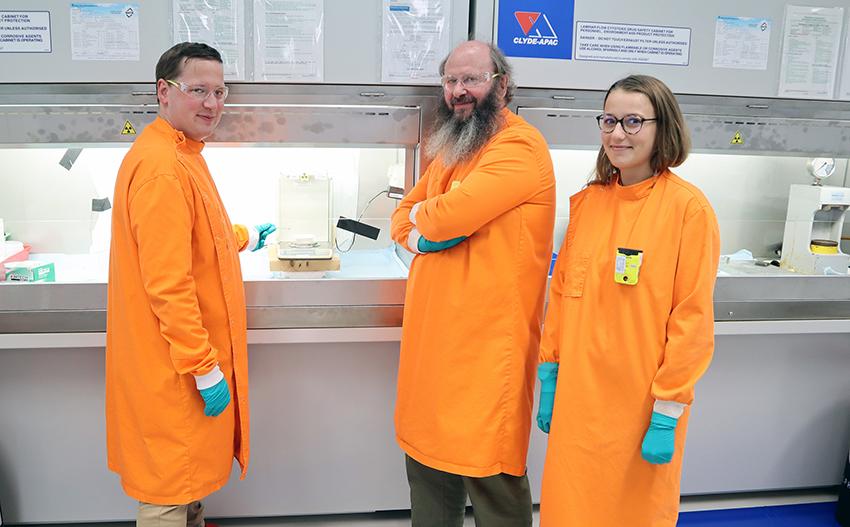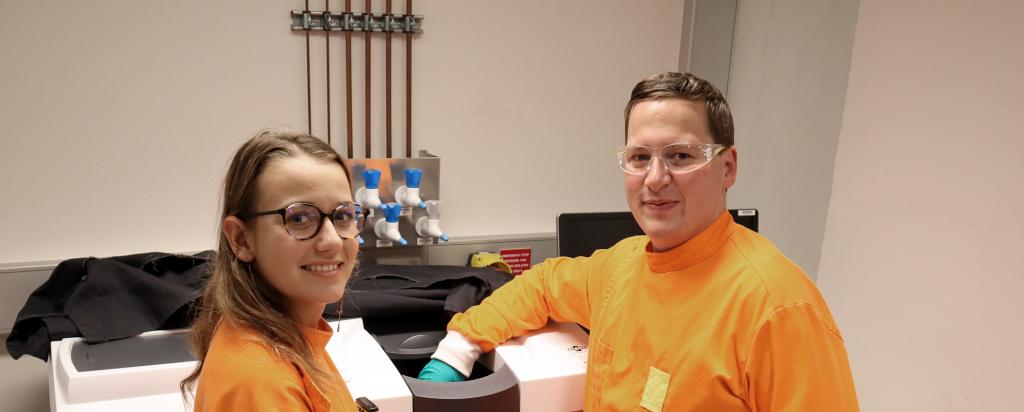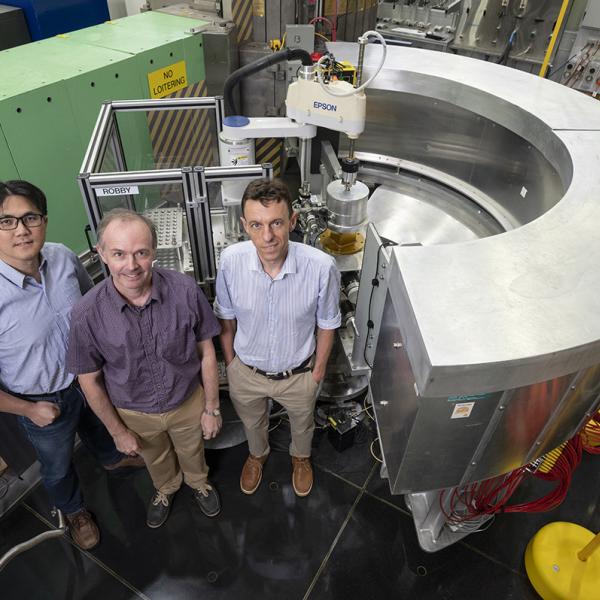

Published on the 14th September 2023 by ANSTO Staff
Two early career nuclear scientists, who received international scholarships to spend time in the Nuclear Fuel Cycle group at ANSTO and in France, are making progress on their work to improve nuclear fuel.
Anna Hautecouverture, a PhD candidate from CEA, received the 2022 AINSE ANSTO and the French Embassy Scholarship (SAAFE), which fosters research collaborations between France and Australia, in nuclear science and engineering in the research areas of human health, the environment, and the nuclear fuel cycle.
She is investigating novel fuel fabrication pathways to recycle fuel, a major focus of research in the nuclear industry to improve its sustainability.
Dr Tim Ablott, a nuclear chemist, who works in the Nuclear Fuel Cycle group at ANSTO, received a United Uranium Scholarship from the United Uranium Trust which supports scientific research and education in the field of nuclear energy by a young scientist. He was able to travel to CEA in France and collaborate with the nuclear fuel group at CEA (where Anna works).
Tim’s research focuses on nuclear fuels, such as doped uranium oxide (UO2) and mixed oxide (MOX) fuels.
“It is really encouraging to see the new generation of nuclear fuel researchers with such promising areas of investigation. Our connection with CEA is an important one and has been really beneficial for Tim and his work. I think that Anna found the time she spent with us to be productive and complementary to her studies,” said Prof Gordon Thorogood, Senior Nuclear Chemist.
Anna has made a detailed study of the co-conversion of plutonium and uranyl nitrates into an oxide powder form by solution combustion synthesis for her PhD.
The ultimate goal is the recycling of nuclear fuel by recovering the actinides, uranium and plutonium and re-using them as a mixed oxide fuel (MOX) in pellet form.
The co-conversion method she explored is based on a redox reaction between oxidant precursor (metal nitrate) and an organic compound (which acts as fuel for the combustion) directly dissolved in solution.
The reaction occurs at the relatively low temperature of 300°C.
Her experiments involved determining the best ratios of the organic fuels, glycine and citric acid, for the synthesis process to produce a homogenous crystallised powder.
“The optimal ratios are quite different according to the fuel and according to the actinide studied,” said Anna.
“One of my goals is to understand why there are such differences and why it is possible to reduce uranium(VI) into uranium(IV) with the right amount of fuel in the system,” she said.
While at ANSTO, Anna acquired information about uranium oxidation state in the UO2+x and (U,Ce)O2 powders obtained by solution combustion synthesis, as well as gained a better understanding of the mechanism of the uranium(VI) reduction into uranium(IV) during the synthesis.
An optimal co-conversion could yield a more uniform distribution of actinides, as well as higher plutonium (Pu) concentrations in the final fuel pellet.
One area of Tim’s work also has a major focus on MOX fuels, which has the major benefit of using Pu as a fuel source. As the amount of spent fuel and retired nuclear weapons is always accumulating, the Pu present in these materials can thus be viewed as a resource rather than as waste.
MOX fuels, proposed for the new generation of nuclear reactors are sub-stoichiometric, in order to prevent the oxidation of the UO2 and improve their thermal properties.
In particular, the mixed oxide fuels with the chemical formula (U1-yPuy)O2-x, also mitigate the risk of cladding corrosion as fuel burnup increases. The ideal Pu proportion of plutonium in this fuel is thought to lie between 30 and 50 wt%.
Importantly, a phase separation occurs in the oxygen deficient region of (U1-yPuy)O2-x compounds.
While at the CEA, Tim’s main focus was the (U,Ce)O1.94 system, but also extended to the (U,Y)O1.94, (Th,Ce)O1.94 and (Th,Y)O1.94 systems at different temperatures from room temperature to 600K, to characterise the phase transition.
He is using results from neutron diffraction collected on the Echidna High Resolution Powder Diffractometer at ANSTO's Australian Centre for Neutron Scattering and thermal measurements at the CEA to develop a physical model based on the behaviour of anionic defects.
He was able to evaluate whether cerium (Ce0 can suitably act as a surrogate for Pu in these mixed oxide studies and found that, whilst exhibiting a similar anionic system, there is a clear lack of data in this area, indicative of the need for further study.
“My ultimate goal is to model the phase transition in these uranium (thorium) oxides in a more realistic way and to incorporate such models in thermodynamic data bases, like CALPHAD and ThermoCalc, and to extend this understanding to how these materials are considered experimentally,” said Tim.




